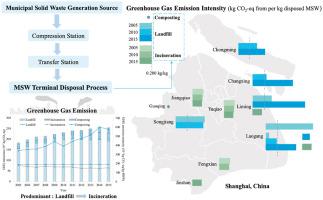Journal of Cleaner Production ( IF 9.7 ) Pub Date : 2021-02-10 , DOI: 10.1016/j.jclepro.2021.126338 Yijun Liu , Siqin Chen , AJ Y. Chen , Ziyang Lou

|
Municipal solid waste (MSW) is one of the main anthropogenic greenhouse gas (GHG) emission sources. GHG emissions from the waste sector could rely on the disposal process greatly, and the corresponding GHG emission intensity (GHG emissions from per kg disposed MSW) might reflect the city’s waste management level. Shanghai, as the popular megacity in China, has witnessed the evolution of the waste disposal processes from landfill dominated to incineration dominated from 2005 to 2015, and the detailed GHG emission estimation was implemented combining the method recommended by IPCC and the bottom-up method. It was found that landfill contributed to 81.88% of total GHG emissions from 2005 to 2015, while the GHG emissions from incineration plants increased from 1.8108 to 3.8108 kg CO2-eq (CO2 equivalent) in the same period, with the amount of incinerated MSW increasing from 1.02109 to 2.50109 kg. The GHG emission intensity of the MSW management system reached 0.363 kg CO2-eq per kg MSW in 2012 but declined to 0.354 kg in 2015. And the GHG emission intensity of incineration was lower than that of landfill and composting, which fluctuated between 0.147 and 0.177 kg CO2-eq per kg MSW. Both the scale and the operation conditions of the waste disposal facilities could influence the GHG emission intensity. With the implementation of waste source sorting and incineration dominated in disposal processes, around 54.07% of GHG emissions could be reduced under the 2030 NP (New policy) scenario. GHG emission intensity could be employed as an indicator for waste disposal development levels.









































 京公网安备 11010802027423号
京公网安备 11010802027423号